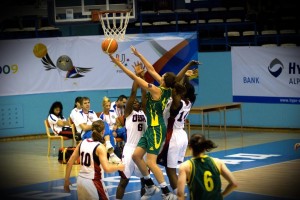Thinking about Help Defence
Help Defence plays a very important part of a team’s defensive prowess. A good help defence focuses on filling the gaps exposed by the offense. Theses gaps can be for any number of different technical or tactical reasons. The Help defence however looks to take away or limit any advantage created by an offense and in turn ensure a more defensively desirable outcome is taken.

It should be noted up front when discussing help defence that the moment another player with the team assists in guarding a ball handler that there is always going to be an overlap and offensive opportunity exposed. Therefore, a coach in planning the various rotations or movements to be rehearsed and implemented into a team’s defensive philosophy needs to accept that by triggering a help defence rotation they are in fact exchanging one scoring opportunity for another.
Another common misconception often just adopted by coaches is that to force more and more ball rotation, is to improve the chances of breaking down the offense and lowering the success of a scoring opportunity. This is simply not the case and the blind following of this strategy only leads to higher percentage shots occurring, and defensive players fighting to cover a shot rather than consolidating their positioning. An example of this philosophy leading to problems can be seen in games when quick ball rotation forces and post defender to make a judgement about staying with their player or rotating into a long close-out to stop an uncontested long range jump-shot. For many coaches and player the instinctive behaviour adopted is to rotate quickly towards the ball contesting the shot. But is this the most pragmatic response?
Maybe the post defender should remain instead with the interior offensive player and rely on other players rotating from one side of the floor to the other to contest the shot. This of course keeps the post defender around the keyway and in a more favourable position for rebounding and also does not leave a possible post target open for an entry pass.
A very common issue seen in help defence within teams is the compounding of mistakes. It would not be unusual in viewing any game that a player guarding the ball makes a mistake and the help defence is triggered. As all players on defence start to rotate to compensate for the breakdown they inherently, create more errors that only compound the situation further to advantage of the offense. The majority of teams can recover from one mistake on defence. A minority of teams can recover from two consecutive mistakes. However, it is almost a certainty that when three mistakes made it always results in a lay-up.
The problems for many defences in minimising mistakes comes from one commonly used technique, the close-out. Players once rotating one or two positions often become overcome with an eagerness to rotate with pace at the peril of their technique and control. Coaches must focus on including these types of scenarios into their training sessions so players can limit poor performance in this intense and challenging stages of play.
The final step of a help defence’s rotation is in rebounding. A frantic and hastily executed help defence often leads to many offensive players not being boxed-out or challenged following the shot. This in some cases leads to an even more high percentage shot occurring because there is no securing of possession. From the earlier example discussed above about the post defender there are times when the rotation should not and must not happen for risk of giving too great of an advantage to an offense.
Help defence is a necessity. It builds a number of safe guards against one on one basketball where there is always inequity. Help defence looks to take away the advantage of the better athlete or more competent player by putting five defenders against the ball. It is the defensive philosophy in regards to the tactics chosen which need to be thought about by every coach in helping to promote a smarter and more reliable help defence.







